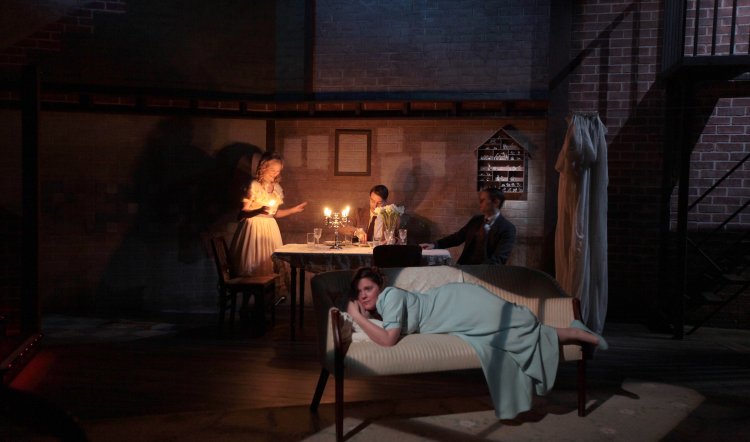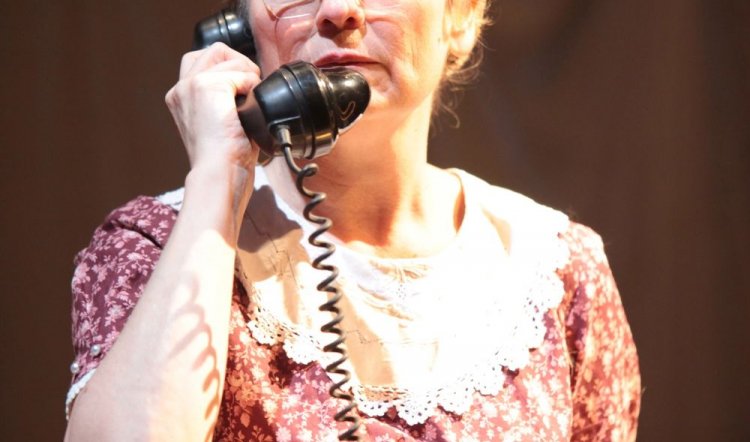
THE GLASS MENAGERIE
THE GLASS MENAGERIE, Ensemble Theatre, 17 July-10 August 2013. Photos by Natalie Boog, above: Vanessa Downing, Tom Stokes and Eric Beecroft - foreground: Catherine McGraffin. Right: Vanessa Downing.
In his original introduction and instructions for The Glass Menagerie, Tennessee Williams wrote – apropos the occasional music – that it represented "the surface vivacity of life with the underlying strain of immutable and inexpressible sorrow". He could have been describing the play in its entirety. The first of his deeply autobiographical plays and – in 1944 – his first box office and critical hit, The Glass Menagerie is superficially vivacious and often funny while the tragedy and sorrow lurk just beneath that surface and eventually overwhelm the whole.
It's a remarkable play – richly and traditionally written (it makes a great read on the page, which is not always the case with stage plays) it is also adventurously theatrical. It begins with Tom Wingfield (Tom Stokes) declaring himself to be the narrator and that what we are about to see is a play. The story that follows is the beginning of Williams's lifelong quest to explore and explain the agony of his relationships with the two women in his life: his sister and his mother.
In Mark Kilmurry's new production he has assembled a quartet of fine performers and their work is to be savoured. It begins with Stokes as the young man trapped in a dead end job, yearning to write and ultimately to abscond – as his father had sixteen years previously. Tom is paralysed by his helpless yet overbearing mother Amanda (Vanessa Downing) and his "crippled" and emotionally broken sister Laura (Catherine McGraffin). All three inhabit a mean apartment in an even meaner part of an airless Southern town from which there is no relief - from the noise of the dancehall across the alley, from the dingy environs nor from the oppressive summer heat.
Tom's escape is his poetry and dreams, Amanda – a faded belle – escapes into her past where once she was the toast of "seventeen gentlemen callers". Laura, incapacitated by a gammy leg and its attendant self consciousness, escapes into her self-constructed world of the glass menagerie. This extensive collection of glass ornaments occupies her fully in arranging and rearranging, cleaning and polishing, dreaming and devising stories and, of course, includes a unicorn.
Into this stultifying but secure world comes the one thing Amanda desires and that Laura dreads: a Gentleman Caller, Mr O'Connor (Eric Beecroft). He is a nice young man who works as a clerk at the same manufactory that pays Tom his miserly $65 per month and is Tom's only friend. Like all good catalysts, nothing remains the same and all is both lost and found when he arrives for dinner.
Tennessee Williams could have been writing with Vanessa Downing in mind when he described the character who is his own mother: "a little woman of great but confused vitality clinging frantically to another time and place. Her characterisation must be carefully created, not copied from type. She is not paranoiac, but her life is paranoia. There is much to admire in Amanda, and as much to love and pity as there is to laugh at. Certainly she has endurance and a kind of heroism, and though her foolishness makes her unwittingly cruel at times, there is tenderness in her slight person."
Downing inhabits this awful and tragic woman with such passion and poignancy it is close to unbearable to see and hear her delusions and disintegration. For her part Catherine McGraffin makes Laura a mesmerising figure. Unable to see or feel her own worth, she is like a butterfly trapped against a window pane; she flutters with increasing feebleness, injuring her psyche with each attempt. She can see the sun and the world beyond, but she can't reach it and her brother is unable to help her – to his eternal pain and sorrow.

Both Eric Beecroft and Tom Stokes bring their hearts and minds fully into the roles of the two young men. They deliver nuanced, energetic yet subtle performances that complement the place of the two women and the four achieve terrific things with this rewarding but not easy play. Taken ill just before the opening, director Mark Kilmurry was not in the theatre for the premiere performance but the way the actors work with the script and one another suggests they were as ready and able as they're ever likely to be.
The same cannot be said of Lucilla Smith's set and costumes, however. The costumes – the setting is 1939 sinking-middle class America - are mainly fine, particularly for the men. But Amanda's 70s-style orangey Afghan coat trimmed with white goat fur is ridiculous. Similarly, Amanda's other wardrobe malfunction is the Scarlett O'Hara semi-crinoline dragged out for dinner with Mr O'Connor. Amanda is already a pathetic figure of fun – titters at her risible clothing are just cruel.
Nicholas Higgins does a sympathetic job with the lighting (see main photo) but the set is something else. Williams stipulates of the setting only that there must be fire escape stairs – nothing else need or should be naturalistic (it is a "memory play", after all). So although the cluttered design of a seedy brickwork and wallpapered living room, with furnishings, may have seemed like a good idea at the time, it isn't. More than that, the logic of the apartment's layout is not only entirely absent, it's absurd. Having the actors repeatedly walk off into the wings then back onstage to ascend or descend the stairs is somewhere between crazy and humiliating.
The design also relegates the central and vital motif of the menagerie of glass animals to the back wall and a largely unseen cluster at the foot of the stage. The meaning and power are lost. And, the tatty cheesecloth curtain that gets dragged back and forth across the stage for no good reason – except to distract from the action and the actors – is at least a bad idea that could be unhooked and disposed of right away. That the company is so good, despite their surroundings, says much about their talent and fortitude.
A directorial decision that should be noted and applauded is the use of fake cigarettes. Kilmurry has employed mime techniques in the past when called upon to smoke on stage and it works in some contexts. In this instance, however, the times call for each of the guys to deploy a Zippo as part of their masculinity and to smoke often. They do it with conviction – and there's not a whiff of smoke or a lighted fag in the auditorium. If it's good enough for the streets and eateries of our town, it's good enough for its stages too. This is the way it should be done. Bravo!
And bravo too for a richly-performed version of one of the great plays of the 20th century. It's selling well already and will extend and transfer – you should take advantage of that.



